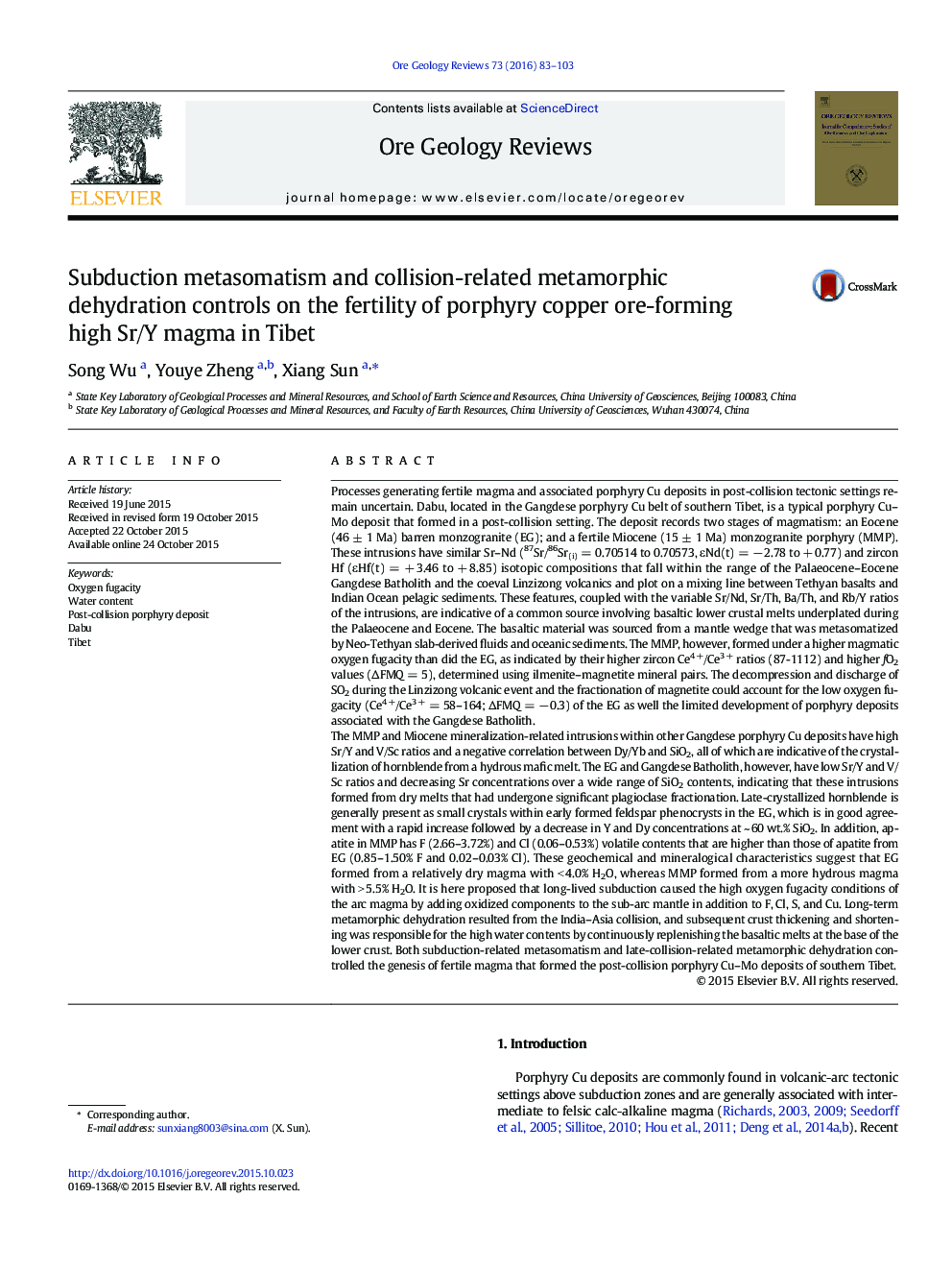| کد مقاله | کد نشریه | سال انتشار | مقاله انگلیسی | نسخه تمام متن |
|---|---|---|---|---|
| 6435870 | 1351862 | 2016 | 21 صفحه PDF | دانلود رایگان |
- The Miocene monzogranite porphyry (MMP) has higher fO2 and water than the Eocene monzogranite (EG).
- The decompression and discharge of SO2 through Linzizong volcanism reduced the fO2 of the EG.
- The water released by metamorphic dehydration reactions increased the water contents of the MMP.
- Subduction metasomatism and metamorphic dehydration controlled the genesis of post-collision porphyry deposits in Tibet.
Processes generating fertile magma and associated porphyry Cu deposits in post-collision tectonic settings remain uncertain. Dabu, located in the Gangdese porphyry Cu belt of southern Tibet, is a typical porphyry Cu-Mo deposit that formed in a post-collision setting. The deposit records two stages of magmatism: an Eocene (46 ± 1 Ma) barren monzogranite (EG); and a fertile Miocene (15 ± 1 Ma) monzogranite porphyry (MMP). These intrusions have similar Sr-Nd (87Sr/86Sr(i) = 0.70514 to 0.70573, εNd(t) = â 2.78 to + 0.77) and zircon Hf (εHf(t) = + 3.46 to + 8.85) isotopic compositions that fall within the range of the Palaeocene-Eocene Gangdese Batholith and the coeval Linzizong volcanics and plot on a mixing line between Tethyan basalts and Indian Ocean pelagic sediments. These features, coupled with the variable Sr/Nd, Sr/Th, Ba/Th, and Rb/Y ratios of the intrusions, are indicative of a common source involving basaltic lower crustal melts underplated during the Palaeocene and Eocene. The basaltic material was sourced from a mantle wedge that was metasomatized by Neo-Tethyan slab-derived fluids and oceanic sediments. The MMP, however, formed under a higher magmatic oxygen fugacity than did the EG, as indicated by their higher zircon Ce4 +/Ce3 + ratios (87-1112) and higher fO2 values (ÎFMQ = 5), determined using ilmenite-magnetite mineral pairs. The decompression and discharge of SO2 during the Linzizong volcanic event and the fractionation of magnetite could account for the low oxygen fugacity (Ce4 +/Ce3 + = 58-164; ÎFMQ = â 0.3) of the EG as well the limited development of porphyry deposits associated with the Gangdese Batholith.The MMP and Miocene mineralization-related intrusions within other Gangdese porphyry Cu deposits have high Sr/Y and V/Sc ratios and a negative correlation between Dy/Yb and SiO2, all of which are indicative of the crystallization of hornblende from a hydrous mafic melt. The EG and Gangdese Batholith, however, have low Sr/Y and V/Sc ratios and decreasing Sr concentrations over a wide range of SiO2 contents, indicating that these intrusions formed from dry melts that had undergone significant plagioclase fractionation. Late-crystallized hornblende is generally present as small crystals within early formed feldspar phenocrysts in the EG, which is in good agreement with a rapid increase followed by a decrease in Y and Dy concentrations at ~ 60 wt.% SiO2. In addition, apatite in MMP has F (2.66-3.72%) and Cl (0.06-0.53%) volatile contents that are higher than those of apatite from EG (0.85-1.50% F and 0.02-0.03% Cl). These geochemical and mineralogical characteristics suggest that EG formed from a relatively dry magma with < 4.0% H2O, whereas MMP formed from a more hydrous magma with > 5.5% H2O. It is here proposed that long-lived subduction caused the high oxygen fugacity conditions of the arc magma by adding oxidized components to the sub-arc mantle in addition to F, Cl, S, and Cu. Long-term metamorphic dehydration resulted from the India-Asia collision, and subsequent crust thickening and shortening was responsible for the high water contents by continuously replenishing the basaltic melts at the base of the lower crust. Both subduction-related metasomatism and late-collision-related metamorphic dehydration controlled the genesis of fertile magma that formed the post-collision porphyry Cu-Mo deposits of southern Tibet.
Journal: Ore Geology Reviews - Volume 73, Part 1, March 2016, Pages 83-103
